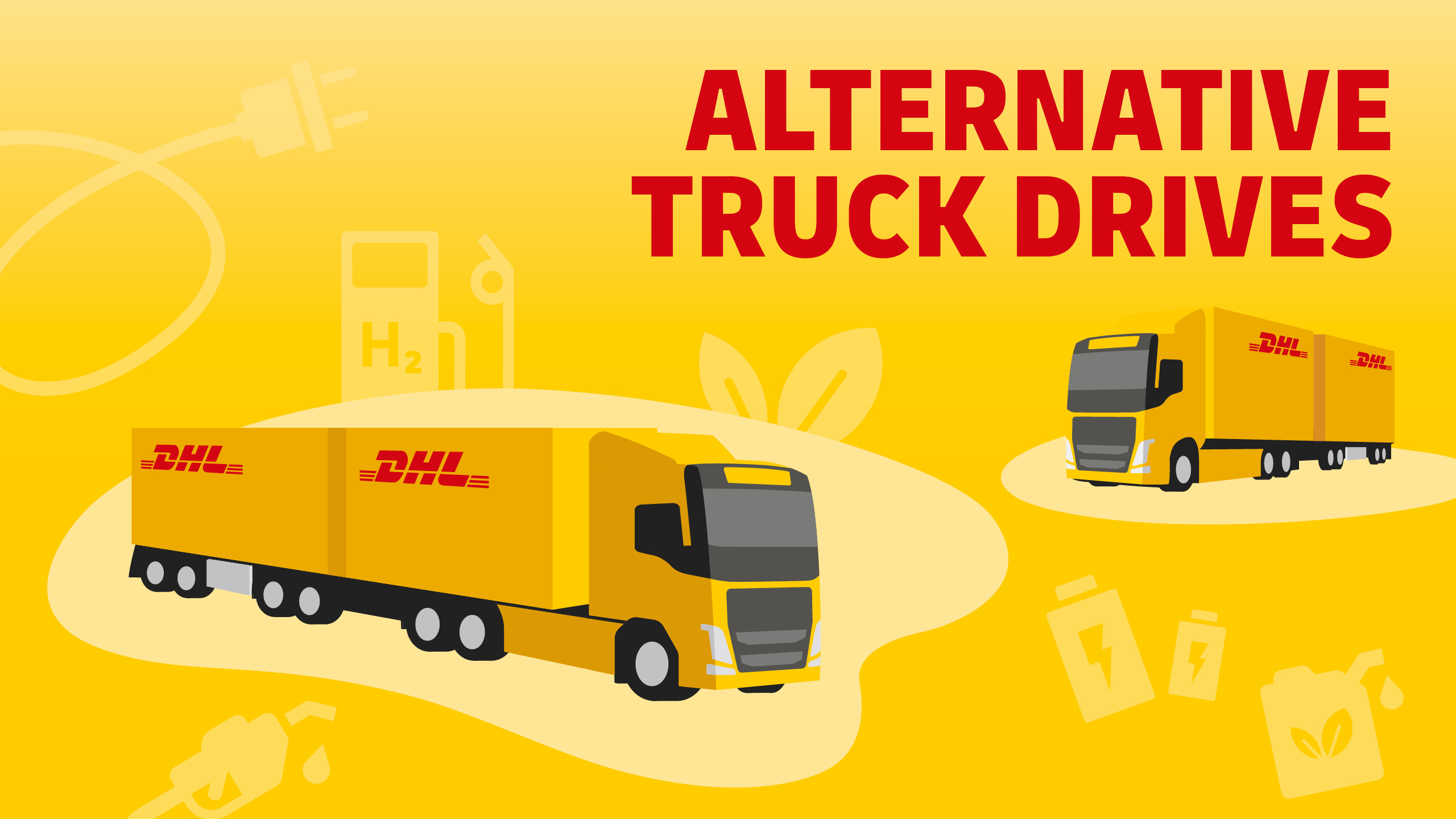
Is the end of the combustion engine approaching even for trucks? If the transportation sector wants to make a greater contribution to climate protection goals, commercial vehicles must emit fewer pollutants. Given the dominance of diesel, this seems like a tall order from today’s perspective. But the market is moving, and DHL Freight is already testing various drive concepts in practice. We provide an outline of the most important alternative truck drive systems.
Alternative Truck Drives for Future Logistics
With the growing global exchange of goods, there is significant potential for climate protection in supply chains and freight transport, as logistics and transportation are associated with significant greenhouse gas emissions. Commercial vehicles are currently responsible for about one-third of greenhouse gas emissions in the transportation sector. In particular, long-haul trucking, which is still predominantly diesel-powered, is a major source of CO2 emissions.
There is widespread agreement that the road transport of the future must be environmentally friendly. In concrete terms, this means that it should be associated with as few direct and indirect emissions as possible. The EU stipulates that greenhouse gas emissions from new heavy goods vehicles should be reduced by 45% from 2030, 65% from 2035 and 90% from 2040 compared to 2019 levels.

Alternative Truck Drives at a Glance
What specific propulsion technologies are we talking about? They can be divided into low-emission technologies and fuels, and zero-emission technologies. Low-emission technologies all use combustion engines. Although they emit less CO2 and other pollutants than diesel drives, they are not free of harmful direct exhaust gases.
Low-emission technologies and fuels for trucks are mainly HVO (hydrotreated vegetable oil, renewable diesel), bio-CNG (compressed natural gas, in this case compressed biomethane) and bio-LNG (liquefied natural gas, in this case biogas), as well as biodiesel (FAME), synthetic fuel (GTL, “gas to liquid”) and ethanol.
E-mobility and hydrogen technologies can be operated with zero emissions if the energy sources are renewable.
HVO
HVO is vegetable oil that has been treated with hydrogen. The oil comes from sources such as residual and waste materials, e.g. grease from the catering industry. After reaction with hydrogen, the properties of the oil are very similar to those of diesel. Like biodiesel, HVO can be blended with conventional diesel or replace it completely. The sustainability of HVO depends on several factors. Hydrogenation requires energy, and the hydrogen itself should be produced using green energy wherever possible. Raw materials require further attention – for instance, the use of palm oil should be avoided from an environmental point of view, as palm oil is usually grown in areas where tropical rainforest existed only a few years or decades ago.
CNG
CNG is made by compressing natural gas to less than one percent of its original volume. CNG can replace diesel fuel. CNG vehicles are less polluting and gas engines are generally more energy efficient than diesel engines. When biogas from renewable sources is used instead of natural gas, CO2 emissions can be reduced by more than 80 percent. Despite the compression, CNG vehicles require more space for fuel storage than diesel vehicles. For this reason, CNG is generally only suitable for shorter delivery distances. In addition, leaking methane – the main component of natural gas – is a potential problem for the environment and climate.
LNG
LNG has a high energy density and a much smaller volume than CNG. To produce LNG, natural gas is cooled to below -161°C and thus liquefied. This reduces the volume of the gas by a factor of 600 compared to the same volume in its gaseous state. LNG is particularly suitable for long-distance road freight. LNG trucks can meet the emission limits of existing and future EU standards at low cost. As with CNG, biogas should be used to produce LNG, so that emissions savings of around 80% are also possible.
Biodiesel
In the EU, biodiesel is derived from vegetable oils or recycled fats from the catering industry, for example. Truck biodiesel is also known as fatty acid methyl ester (FAME). It can be used directly or blended with conventional fossil diesel. In the EU, blends of up to 7 percent FAME biodiesel are common. Higher blends may require engine modifications. Biodiesel is eco-friendly when fats or oils from sustainable sources, such as waste materials, are used.
GTL
Methane can be converted into a fuel by first breaking it down and then refining it into a synthetic liquid fuel. This has the same technical properties as fossil fuels. Synthetic fuels can also be made from other raw materials. Although GTL diesel reduces the emissions of conventional vehicles, it requires a lot of energy to produce. The environmental impact of GTL therefore depends primarily on its production.
Battery-electric Drives
Electric trucks with a highly efficient electric motor are powered by electricity that increasingly comes from renewable energy sources. Electric vehicles produce no direct pollutants or noise. If green electricity is used, an all-electric vehicle is CO2 neutral. Hybrid vehicles, which combine combustion and electric motors, can also save energy and reduce CO2 emissions.
In addition to the high cost, another challenge with electric trucks is the low energy density of electricity. This limits the range of the vehicles. Moreover, charging takes a very long time, depending on the charging capacity. Fast charging is possible with high-power DC.
Continuous improvements in battery technology are critical to the market acceptance of electric trucks. Although more and more e-trucks are entering the market, their range still limits their deployment. In addition, the heavy weight of the batteries reduces the permissible payload. For this reason, electric trucks are mainly used for urban and regional deliveries.
So far, only battery electric trucks have been discussed. In Sweden and Germany, though, tests are underway with trucks powered by overhead power lines, and DHL is also investigating the technology. One thing is certain: in principle, overhead power lines can be used for trucks. Nevertheless, questions of expansion and standardization, also on an international scale, as well as economic efficiency (high up-front costs for building the infrastructure) have put the brakes on the concept. As a result, it is questionable whether overhead power lines for electric trucks will ever be used in regular operation.
Hydrogen
Hydrogen-powered truck engines use fuel cells to convert hydrogen and oxygen from the air into heat, water, and electricity. The heat and water are emitted through the exhaust, while the electricity powers the engine via a battery that stores the electricity temporarily.
Alongside battery-powered electric vehicles, hydrogen fuel cells are an important technological alternative for long-distance road haulage. Fuel cell technology is being developed at full throttle to achieve greater efficiency and cost effectiveness. For the environmental balance, it is crucial that renewable electricity is used for the energy-intensive production and conversion of hydrogen.
Hydrogen has a relatively high energy density, which means that hydrogen-powered trucks can achieve long ranges. Hydrogen could therefore become an excellent alternative to diesel for long-haul operation, especially since fuel cell trucks can be refueled almost as quickly as diesel trucks.
For this to happen, hydrogen technology needs to become more market-ready. Green hydrogen, which is still in short supply, is also urgently needed in other industries, such as steel production.

Sustainable Trucks: Status quo and Existing Infrastructure
Low-emission transport is an overarching EU policy goal. However, there is an EU-wide new registration quota of only five percent of trucks and tractor units with alternative drive systems (electric, hybrid, CNG, LNG) by 2023. About 95 percent of trucks in the EU still run on diesel.
The corresponding infrastructure is developing differently depending on the type of drive (and with considerable national differences). Electromobility in particular is making progress in Europe: the number of public charging points has increased to more than 600,000 by 2023 (including cars; DC and AC; all charging speeds). This is almost a sixfold growth compared to 2020. In contrast, the 248 hydrogen refuelling stations in the EU (2023) are a negligible number.

Funding for Trucks with Alternative Drives
A major obstacle to the implementation of alternative propulsion systems in road freight is therefore still the inadequate charging and refueling infrastructure. As part of the European Green Deal 2023, the EU institutions have agreed on binding national targets for the expansion of alternative fuel charging and refueling stations. For example, charging stations for trucks and buses must be available every 120 kilometers along the main trans-European transport routes by 2028, and every secured truck parking area must be equipped with a charging station by the end of 2030. National funding programs complement the EU requirements.
As for direct funding of alternative-drive trucks, they benefit from reduced road tolls in some countries. The EU also authorizes national funding programs for its member states to support companies and businesses that purchase sustainable trucks. Such subsidies are not available everywhere and vary from country to country.

Alternative Drives at DHL Freight
For us at DHL Freight, alternative drive systems are crucial to achieving the sustainability goals of the entire DHL Group: reducing the carbon footprint by 30 percent until 2030 compared to 2019 and bringing all logistics-related emissions to net zero by 2050.
DHL Freight is open to all technologies and already deploys more than 200 vehicles in Germany alone with no direct or significantly reduced greenhouse gas emissions in regular operation: battery electric, bio-CNG and bio-LNG vehicles. DHL Freight aims to have at least 1,000 HVO, bio-LNG, bio-CNG and electric vehicles on the road in Europe by 2025, and to increase the share of sustainable fuels to over 30 percent by 2030.
To accelerate development, we are participating in hydrogen research projects such as HyCET and are testing hydrogen trucks in pilot operations. Further pilot projects for local and long-distance transport are constantly being added, with both battery-electric and hydrogen-powered vehicles – from vans to tractor-trailers.



